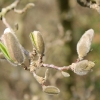Features
This woody, deciduous perennial forms a rounded shrub or small tree. In early spring it bears grey, furry buds which open into 10cm wide white flowers, sometimes with a light pink flush, from March to April. The lightly scented flowers each have up to 18 tepals and appear before the leaves. The long green leaves then arrive in late spring and last until autumn.
What to use it for
This is an excellent choice for a small, low maintenance garden, as it won’t grow to an unmanageable size and doesn’t require much looking after. It will also work well in a woodland location (where it will benefit from the shelter of other plants) or in beds and borders.
It suits most garden styles and makes an excellent specimen plant for early flowers. It can also be grown in a container and is useful as a cut flower.
How to look after it
Add plenty of organic matter, such as peat, to the planting hole when planting to retain plenty of moisture.
In the spring add a good layer of mulch to the soil surface to keep the roots shaded, but avoid mounding it up against the stem. An organic mulch, such as manure or leaf mould, is ideal, particularly if the plant is grown on dry soil where it will need extra help with retaining moisture.
How to prune it
Keep pruning to a minimum while the plant is young, just removing any damaged, diseased, dead or crossing branches. Any pruning should be done in midsummer when it’s in full leaf.
If you need to carry out renovation pruning then do this gradually over a two or three year period and be prepared for a very slow recovery.
How to propagate it
There are many options for propagating Magnolia stellata. The most effective options are using simple layering or grafting. Simple layering can be done with low growing stems, layering in the spring then severing the rooted layer from the parent plant the following spring.
For grafting, use a spliced side-veneer graft carried out in autumn or early to mid spring. Chip-budding is another option, which can be done in late summer. Graft the scion onto a rootstock of Magnolia kobus or Magnolia x soulangeana. The plant will mature in 4 to 5 years.
You can also propagate it by taking softwood or greenwood nodal stem tip cuttings in late spring or early summer. Make a shallow wound, about 2cm long, at the base of each cutting to encourage rooting.
To grow from seed, allow the seedheads to dry on the plant before collecting the seeds in the autumn. The seeds will need to be soaked then exposed to cold in order to break their dormancy. Firstly, separate the individual fruits then soak them in warm water with a little washing up liquid for a day or two until the flesh has softened and can be removed. Sow the seeds straight away in a cold frame, or mix them with moist coir, vermiculite or sand in a plastic bag, make sure there’s some air in the bag, then seal it and keep it in the fridge for a couple of months before sowing the seeds in the cold frame in early spring. If only a few seeds have germinated by the following summer, transplant these then return the rest to the cold frame to see if they emerge the following year.
Common problems
Magnolia buds and flowers can be damaged by the attentions of birds and by frost if they are exposed to morning sunshine. They can also be affected by grey mould.
The leaves can be affected by capsid bugs, fungal leaf spot, viruses (viral symptoms are often attributed to the cucumber mosaic virus) and horse chestnut scale. Coral spot, honey fungus and snails can also be a problem.
Other useful information
Magnolia stellata was originally thought to be a variety of Magnolia kobus, but has since been identified as a separate species.









